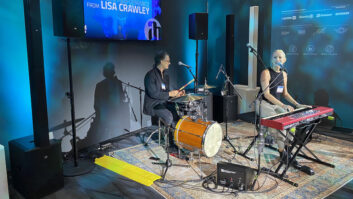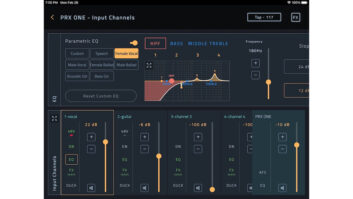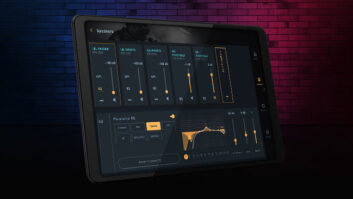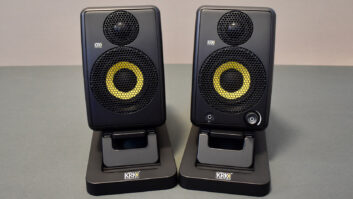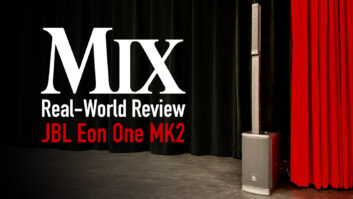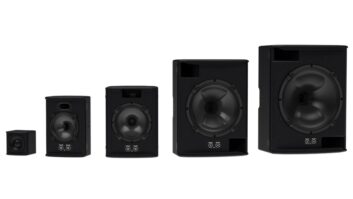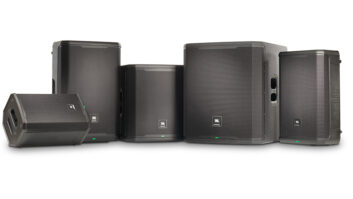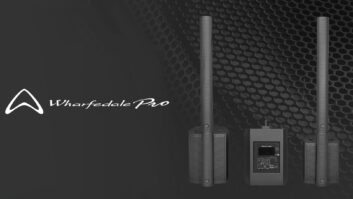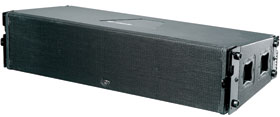
It used to be that you needed a degree in rocket science to set up a P.A. system. Mixers, compressors, reverbs, delays, crossovers, power amps and loudspeakers all required careful matching and a fair amount of technical background to ensure proper operation. As technology has progressed, becoming more efficient and miniaturized, many of these components have been simplified and/or integrated.
The portable-P.A. market has certainly grown since the mid-1990s, when the first powered loudspeaker intended for sound reinforcement was introduced, and today it is experiencing something of a boom, with a plethora of products ranging from powered speakers with onboard mixers to compact line arrays that can be set up easily by a single (non-bodybuilder) person.
DAS Aero 38
Hartley Peavey, founder and CEO of Peavey Electronics Corp., has seen his share of changes. “Back in the 1960s when I entered the sound reinforcement market,” he says, “you had a choice of the Shure Vocal Master or Kustom K200 [which was basically a warmed-over guitar amplifier]. At the time the Vocal Master retailed for $1,000, and if you scaled that amount to today it would be about $10,000. With the first Peavey 100-watt ‘packaged’ P.A. selling for around $600, we were trying to bring the price down to a point where musicians could afford it. We really have come a long way in terms of the value we can offer our customers for their dollars, and packaged P.A. is still a very large part of our business.”
Richard Ruse, senior director of global sales for JBL Professional, sees “an incredible surge in portable P.A. sales in the price range between $600 and $1,000. That is the ‘meat and potatoes’ of portable P.A. right now and it is essentially powered speakers. Until the time we introduced the original EON, you needed an external amplifier, and if you planned to use a subwoofer you’d need another amp and a crossover. If you really wanted to run the system correctly you’d also need an EQ, a compressor, and somebody who knew how to wire everything together and set them up so that the system did not sound like a telephone. The men and the boys were separated technologically by how much gear they brought to the gig.

JBL PRX425
“These days, it’s all about simplicity and convenience,” Ruse continues. “People want to get in and get out. Take the average customer of a mobile DJ: the wedding party. They don’t care about the technical details, but in general they’re exposed to better audio now than they were five or 10 years ago. It’s similar with the local blues band.”

Meyer Sound UM-1P
While the market may be booming, it’s not necessarily because of any recent revolutionary breakthroughs. “Innovation in this category does not come along quite as frequently as it did before,” says Ray van Straten, director of marketing communications at QSC Audio Products. “How many ways can you skin a P.A.? It used to be that you’d go to a trade show every year and say, ‘Holy cow, did you see that?’ When you don’t have these frequent, gigantic leaps in technology, it allows companies to quickly catch up with the state of the art. It’s great for the customer because it creates competition and keeps everyone on their toes. Because of that, high levels of product performance are now accessible to a very broad range of users.”

Peavey SP 4BX
Peavey agrees, stating, “Technologies progress fairly rapidly until they reach a certain point where the progression slows down. Right now it’s like automobile racing. One race car is not three laps ahead—maybe 20 feet, but not three laps. The speaker is still a cone, a coil of wire and a magnet. With all of the problems inherent in that design, it’s still the best means of moving air in a linear way.
“That being said, we’re always trying to find better ways of doing things like using a ribbon for the high-frequency driver in our Impulse 12D powered speaker,” Peavey adds. “The ribbon generates a planar wavefront for increased intelligibility without need for a phase plug, which creates distortion and increases listening fatigue. Once you hear that compared to a conventional HF compression driver, you’ll never go back.”

Mackie HD1531
Advances in technology do drive product quality up while keeping prices competitive. Recently, Mackie introduced its HD Series of powered loudspeakers. According to Greg Young, Mackie’s director of product management, “The demands of our customers for a powered loudspeaker were simple—in theory. They want huge power, amazing sound quality, a high portability factor, installability and, of course, a good price. In short, the market wanted an affordable, truly pro option. Our HD Series delivers this for users who need more output than our SRM or Thump Series to fill larger venues, achieve wider coverage and create higher output. This leads to a wide variety of customers including DJs, sound reinforcement companies, rental houses and festivals. The HD Series is also great for our install customers who need a variety of rigging options.”

QSC KW153
ALL ABOARD
Onboard processing has become the de-facto standard for portable P.A., including crossover, compression, system EQ and feedback correction. At the same time, certain traditional audio specs, or measures, are used less and less for comparison.
“When dealing with a powered speaker you have a closed system architecture, Ruse says. “Wattage ratings become irrelevant because you are tying amps, input modules and onboard DSP to the sensitivity of the drivers you’re using. Power rating is only one feature of a system where the whole becomes greater than the sum of the parts.”

Turbosound NuQ-10
According to van Straten, “The questions asked by today’s customers are no longer, ‘How much power does this thing deliver?’ but simply, ‘Does it do what I need it to do?’ and, ‘Is it reliable?’ Looking at it from a performance standpoint, we are experiencing a sort of polarization in the market, where there is a lot of price-driven product at the bottom, and pro-level, performance-driven gear at the top. The gear that is price-driven typically offers one or two measures of performance that the manufacturer can hang their hat on from a marketing perspective, like total SPL. We don’t have a purely entry-point product in any of the categories that we serve because that’s not who we are as a company. Our goal is to provide high performance and overall value to the professional customer at a small premium.
“For example, when QSC brought the K Series to market against the existing competitors in the space, we were $100 to $200 more expensive per cabinet,” he explains. “Why would you do that? Because the professional customer who values the inherent advantages in our products recognizes what they are getting for their money and is willing to pay for it.”

Line 6 StageSource L3t
BATTERIES NOT INCLUDED
In spite of the popularity of powered speakers, demand for passive models is alive and well. Peavey cites the PR Series of loudspeakers as one of its most popular product lines. Mackie recently introduced its S500 Series, and JBL has rolled out its PRX400 Series. But aren’t passive speakers dead?
“There are still large markets around the world where passive speakers and dedicated amplifiers are the preferred system topology,” Young says. “Our customers in these markets have consistently requested these solutions, so we are very pleased to offer the new S500 Series speakers and FRS Series power amplifiers to fill this demand.”

Yamaha S215V
Ruse sees “a huge worldwide market for passive speakers due to the proliferation of legacy amplifiers out there, plus the fact that there needs to be a low-cost installation solution for small bars, VFW halls, civic buildings and churches. One of the reasons we’ve put M10 suspension points on all of our new speakers is to ensure safety and consistency in those applications. Another concern is this: If I have a church, where do I plug in powered speakers? I need an electrician to install outlets near the speakers, at a cost close to that of the amplifier I already own.”
All of the manufacturers we spoke with agreed that the house-of-worship market is strong. “Frankly, there’s not many new clubs being built,” Peavey quips, “but there are incredible numbers of churches being built. What’s unfortunate is that sometimes they’ll build a glorious-looking building without thinking about acoustics. You’ll find hard walls and floors, and it echoes like a chamber. The intelligibility goes out the window so they come to us for help. In fact, I believe that our Sanctuary Series is the only line of products specifically designed for churches.

Yorkville U215
“The thing that keeps us alive in the sound reinforcement field is the ever-growing level of expectation,” Peavey concludes. “Back when I was a young guy, I had a ’57 Chevy with an AM radio. I was perfectly content with that AM radio because I didn’t know any better. Then FM or tape or a CD player comes along, and we expect that higher level as the norm. It is the job of engineering and manufacturing to design better and better loudspeaker systems to meet that expectation. That’s why we exist.”
Steve La Cerra is Mix’s sound-reinforcement editor.
